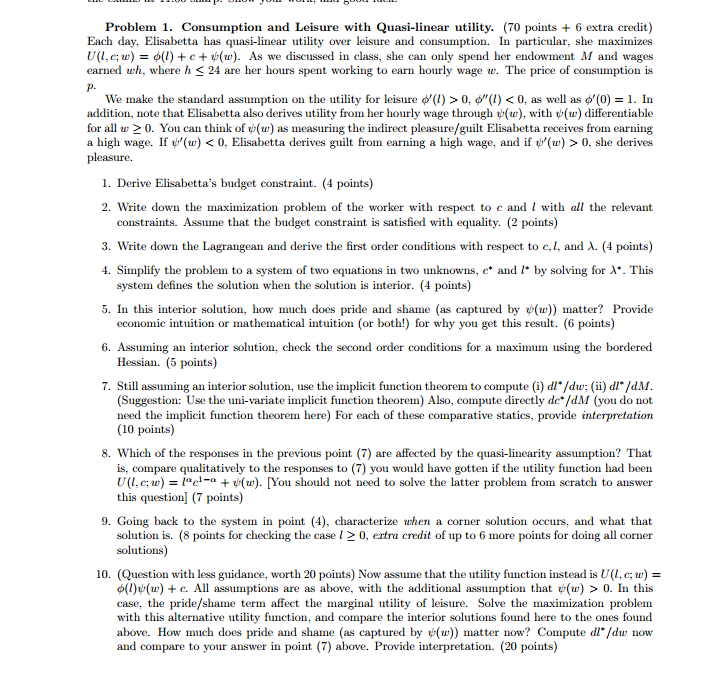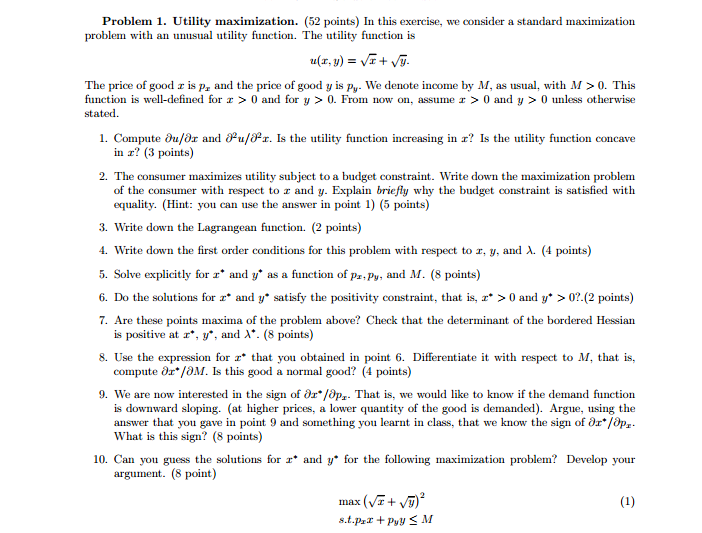

HELP me please
Problem 1. Consumption and Leisure with Quasi-linear utility. (70 points + 6 extra credit) Each day, Elisabetta has quasi-linear utility over leisure and consumption. In particular, she maximizes U(lew) = o(1) + c + (w). As we discussed in class, she can only spend her endowment M and wages earned wh, where A 0, o"(1) 0, she derives pleasure. 1. Derive Elisabetta's budget constraint. (4 points) 2. Write down the maximization problem of the worker with respect to c and I with all the relevant constraints. Assume that the budget constraint is satisfied with equality. (2 points) 3. Write down the Lagrangean and derive the first order conditions with respect to c, , and A. (4 points) 4. Simplify the problem to a system of two equations in two unknowns, c* and I* by solving for A*. This system defines the solution when the solution is interior. (4 points) 5. In this interior solution, how much does pride and shame (as captured by w(w)) matter? Provide economic intuition or mathematical intuition (or both!) for why you get this result. (6 points) 6. Assuming an interior solution, check the second order conditions for a maximum using the bordered Hessian. (5 points) 7. Still assuming an interior solution, use the implicit function theorem to compute (i) dl*/dw; (ii) di* /dM. (Suggestion: Use the uni-variate implicit function theorem) Also, compute directly de*/dM (you do not need the implicit function theorem here) For each of these comparative statics, provide interpretation (10 points) 8. Which of the responses in the previous point (7) are affected by the quasi-linearity assumption? That is, compare qualitatively to the responses to (7) you would have gotten if the utility function had been U(le:w) = look- + (w). [You should not need to solve the latter problem from scratch to answer this question] (7 points) 9. Going back to the system in point (4), characterize when a corner solution occurs, and what that solution is. (8 points for checking the case 1 2 0, extra credit of up to 6 more points for doing all corner solutions) 10. (Question with less guidance, worth 20 points) Now assume that the utility function instead is U(l, c; w) = o(1)(w) + c. All assumptions are as above, with the additional assumption that (w) > 0. In this case, the pride/shame term affect the marginal utility of leisure. Solve the maximization problem with this alternative utility function, and compare the interior solutions found here to the ones found above. How much does pride and shame (as captured by (w)) matter now? Compute dl* /dw now and compare to your answer in point (7) above. Provide interpretation. (20 points)Problem 1. Utility maximization. (52 points) In this exercise, we consider a standard maximization problem with an unusual utility function. The utility function is u(x, y) = VI + vy. The price of good z is p, and the price of good y is py- We denote income by M, as usual, with M > 0. This function is well-defined for x > 0 and for y > 0. From now on, assume : > 0 and y > 0 unless otherwise stated. 1. Compute du/Or and Ou/02r. Is the utility function increasing in r? Is the utility function concave in x? (3 points) 2. The consumer maximizes utility subject to a budget constraint. Write down the maximization problem of the consumer with respect to a and y. Explain briefly why the budget constraint is satisfied with equality. (Hint: you can use the answer in point 1) (5 points) 3. Write down the Lagrangean function. (2 points) 4. Write down the first order conditions for this problem with respect to r, y, and A. (4 points) 5. Solve explicitly for r* and y* as a function of pr, py, and M. (8 points) 6. Do the solutions for a* and y* satisfy the positivity constraint, that is, a* > 0 and y* > 0?.(2 points) 7. Are these points maxima of the problem above? Check that the determinant of the bordered Hessian is positive at r*, y*, and A*. (8 points) 8. Use the expression for a* that you obtained in point 6. Differentiate it with respect to M, that is, compute or* /OM. Is this good a normal good? (4 points) 9. We are now interested in the sign of Or*/Op,- That is, we would like to know if the demand function is downward sloping. (at higher prices, a lower quantity of the good is demanded). Argue, using the answer that you gave in point 9 and something you learnt in class, that we know the sign of Or* /Op,. What is this sign? (8 points) 10. Can you guess the solutions for r* and y* for the following maximization problem? Develop your argument. (8 point) max (vi + vy) (1) s.t.pix + pyy = M










